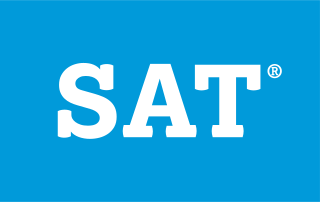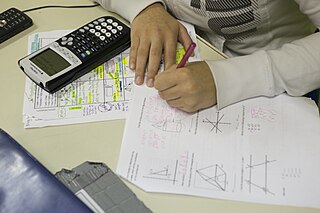Related Research Articles

The ACT is a standardized test used for college admissions in the United States. It is currently administered by ACT, a nonprofit organization of the same name. The ACT test covers four academic skill areas: English, mathematics, reading, and scientific reasoning. It also offers an optional direct writing test. It is accepted by all four-year colleges and universities in the United States as well as more than 225 universities outside of the U.S.

The SAT is a standardized test widely used for college admissions in the United States. Since its debut in 1926, its name and scoring have changed several times. For much of its history, it was called the Scholastic Aptitude Test and had two components, Verbal and Mathematical, each of which was scored on a range from 200 to 800. Later it was called the Scholastic Assessment Test, then the SAT I: Reasoning Test, then the SAT Reasoning Test, then simply the SAT.

A graphing calculator is a handheld computer that is capable of plotting graphs, solving simultaneous equations, and performing other tasks with variables. Most popular graphing calculators are programmable calculators, allowing the user to create customized programs, typically for scientific, engineering or education applications. They have large screens that display several lines of text and calculations.
The Preliminary SAT/National Merit Scholarship Qualifying Test (PSAT/NMSQT) is a standardized test administered by the College Board and cosponsored by the National Merit Scholarship Corporation (NMSC) in the United States. In the 2018–2019 school year, 2.27 million high school sophomores and 1.74 million high school juniors took the PSAT. Scores from the PSAT/NMSQT are used to determine eligibility and qualification for the National Merit Scholarship Program.

Math League is a math competition for elementary, middle, and high school students in the United States, Canada, and other countries. The Math League was founded in 1977 by two high school mathematics teachers, Steven R. Conrad and Daniel Flegler. Math Leagues, Inc. publishes old contests through a series of books entitled Math League Press. The purpose of the Math League Contests is to provide students "an enriching opportunity to participate in an academically-oriented activity" and to let students "gain recognition for mathematical achievement".

Mu Alpha Theta (ΜΑΘ) is the United States mathematics honor society for high school and two-year college students. In June 2015, it served over 108,000 student members in over 2,200 chapters in the United States and in 20 foreign countries. Its main goals are to inspire keen interest in mathematics, develop strong scholarship in the subject, and promote the enjoyment of mathematics in high school and two year college students. The name is a rough transliteration of math into Greek. Buchholz High School won first place in 2023 for the 15th time in the annually held national convention.
The Texas Math and Science Coaches Associationor TMSCA is an organization for coaches of academic University Interscholastic League teams in Texas middle schools and high schools, specifically those that compete in mathematics and science-related tests.
The Secondary School Admission Test (SSAT) is an admission test administered by The Enrollment Management Association in the United States to students in grades 3–11 to provide a standardized measure that will help professionals in independent or private elementary, middle, and high schools to make decisions regarding student test taking.
Advanced Placement (AP) Statistics is a college-level high school statistics course offered in the United States through the College Board's Advanced Placement program. This course is equivalent to a one semester, non-calculus-based introductory college statistics course and is normally offered to sophomores, juniors and seniors in high school.

Core-Plus Mathematics is a high school mathematics program consisting of a four-year series of print and digital student textbooks and supporting materials for teachers, developed by the Core-Plus Mathematics Project (CPMP) at Western Michigan University, with funding from the National Science Foundation. Development of the program started in 1992. The first edition, entitled Contemporary Mathematics in Context: A Unified Approach, was completed in 1995. The third edition, entitled Core-Plus Mathematics: Contemporary Mathematics in Context, was published by McGraw-Hill Education in 2015.
The SAT Subject Test in Chemistry was a one-hour multiple choice test given on chemistry by The College Board. A student chose whether to take the test depending upon college entrance requirements for the schools in which the student was planning to apply. Until 1994, the SAT Subject Tests were known as Achievement Tests; until January 2005, they were known as SAT 2s; they are still well known by the latter name. On January 19 2021, the College Board discontinued all SAT Subject tests, including the SAT Subject Test in Chemistry. This was effective immediately in the United States, and the tests were to be phased out by the following summer for international students. This was done as a response to changes in college admissions due to the impact of the COVID-19 pandemic on education.
The SAT Subject Test in United States History was the name of a one-hour multiple choice test given on United States History by The College Board. A student chose whether to take the test depending upon college entrance requirements for the schools in which the student is planning to apply. Until 1994, the SAT Subject Tests were known as Achievement Tests; and from 1995 until January 2005, they were known as SAT IIs. Of all SAT subject tests, United States History was taken the second most, with 119,903 administrations in 2009. On January 19, 2021, the College Board discontinued all SAT Subject tests, including the SAT Subject Test in United States History. This was effective immediately in the United States, and the tests were to be phased out by the following summer for international students. This was done as a response to changes in college admissions due to the impact of the COVID-19 pandemic on education.
In the U.S., the SAT Subject Test in Mathematics Level 2, was a one-hour multiple choice test. The questions covered a broad range of topics. Approximately 10-14% of questions focused on numbers and operations, 48-52% focused on algebra and functions, 28-32% focused on geometry, and 8-12% focused on data analysis, statistics and probability. Compared to Mathematics 1, Mathematics 2 was more advanced. Whereas the Mathematics 1 test covered Algebra II and basic trigonometry, a pre-calculus class was good preparation for Mathematics 2. On January 19, 2021, the College Board discontinued all SAT Subject tests, including the SAT Subject Test in Mathematics Level 2. This was effective immediately in the United States, and the tests were to be phased out by the following summer for international students. This was done as a response to changes in college admissions due to the impact of the COVID-19 pandemic on education.
Mathematics is one of several academic events sanctioned by the University Interscholastic League. It is also a competition held by the Texas Math and Science Coaches Association, using the same rules as the UIL.
The SAT Subject Test in Physics, Physics SAT II, or simply the Physics SAT, was a one-hour multiple choice test on physics administered by the College Board in the United States. A high school student generally chose to take the test to fulfill college entrance requirements for the schools at which the student was planning to apply. Until 1994, the SAT Subject Tests were known as Achievement Tests; until January 2005, they were known as SAT IIs; they are still well known by this name.
The SAT Subject Test in Biology was the name of a one-hour multiple choice test given on biology by the College Board. A student chose whether to take the test depending upon college entrance requirements for the schools in which the student is planning to apply. Until 1994, the SAT Subject Tests were known as Achievement Tests; and from 1995 until January 2005, they were known as SAT IIs. Of all SAT subject tests, the Biology E/M test was the only SAT II that allowed the test taker a choice between the ecological or molecular tests. A set of 60 questions was taken by all test takers for Biology and a choice of 20 questions was allowed between either the E or M tests. This test was graded on a scale between 200 and 800. The average for Molecular is 630 while Ecological is 591.

Mathematics education in the United States varies considerably from one state to the next, and even within a single state. However, with the adoption of the Common Core Standards in most states and the District of Columbia beginning in 2010, mathematics content across the country has moved into closer agreement for each grade level. The SAT, a standardized university entrance exam, has been reformed to better reflect the contents of the Common Core. However, many students take alternatives to the traditional pathways, including accelerated tracks. As of 2023, twenty-seven states require students to pass three math courses before graduation from high school, while seventeen states and the District of Columbia require four. A typical sequence of secondary-school courses in mathematics reads: Pre-Algebra, Algebra I, Geometry, Algebra II, Pre-calculus, and Calculus or Statistics. However, some students enroll in integrated programs while many complete high school without passing Calculus or Statistics. At the other end, counselors at competitive public or private high schools usually encourage talented and ambitious students to take Calculus regardless of future plans in order to increase their chances of getting admitted to a prestigious university and their parents enroll them in enrichment programs in mathematics.
Additional Mathematics is a qualification in mathematics, commonly taken by students in high-school. It features a range of problems set out in a different format and wider content to the standard Mathematics at the same level.

SAT Subject Tests were a set of multiple-choice standardized tests given by The College Board on individual topics, typically taken to improve a student's credentials for college admissions in the United States. For most of their existence, from their introduction in 1937 until 1994, the SAT Subject Tests were known as Achievement Tests, and until January 2005, they were known as SAT II: Subject Tests. They are still commonly known by these names. Unlike the Scholastic Aptitude Test (SAT) that the College Board offers, which are intended to measure general aptitude for academic studies, the Achievement Tests are intended to measure the level of knowledge and understanding in a variety of specific subjects. Like the SAT, the scores for an Achievement Test range from 200 (lowest) to 800 (highest).
The SAT is a standardized test commonly used for the purpose of admission to colleges and universities in the United States. The test, owned by the College Board and originally developed by Carl Brigham, was first administered on June 23, 1926, to about 8,000 students. The test was introduced as a supplement to the College Board essay exams already in use for college admissions, but ease of administration of the SAT and other factors led to the discontinuation of the essay exams during World War II. The SAT has since gone through numerous changes in content, duration, scoring, and name; the test was taken by more than 1.9 million students in the graduating high school class of 2023.
References
- 1 2 "SAT Subject Test in Mathematics Level 1". The College Board . Retrieved July 6, 2007.
- 1 2 3 "SAT Subject Test Percentile Ranks" (PDF). The College Board . Retrieved July 2, 2007.
- ↑ Compass Education Group SAT FAQ
- ↑ Nick Anderson, College Board is scrapping SAT’s optional essay and subject tests, Washington Post (January 19, 2021).
- ↑ "College Board Will No Longer Offer SAT Subject Tests or SAT with Essay – College Board Blog". blog.collegeboard.org. Retrieved 2021-02-14.
- ↑ Aspegren, Elinor. "Adjusting to 'new realities' in admissions process, College Board eliminates SAT's optional essay and subject tests". USA TODAY.
- 1 2 3 "SAT Subject Tests Preparation Booklet" (PDF). The College Board. pp. 17–22. Retrieved July 6, 2007.
- 1 2 "SAT Calculator Policy". The College Board . Retrieved July 6, 2007.